Garden Paths Design focuses on creating beautiful and functional pathways that lead the way through outdoor spaces. With a blend of natural materials and artistic layouts, these designs enhance the aesthetic of any garden while ensuring ease of movement. Whether it’s for a cozy backyard or a sprawling landscape, the right path can make a big difference in how you experience your garden.
Incorporating Natural Materials
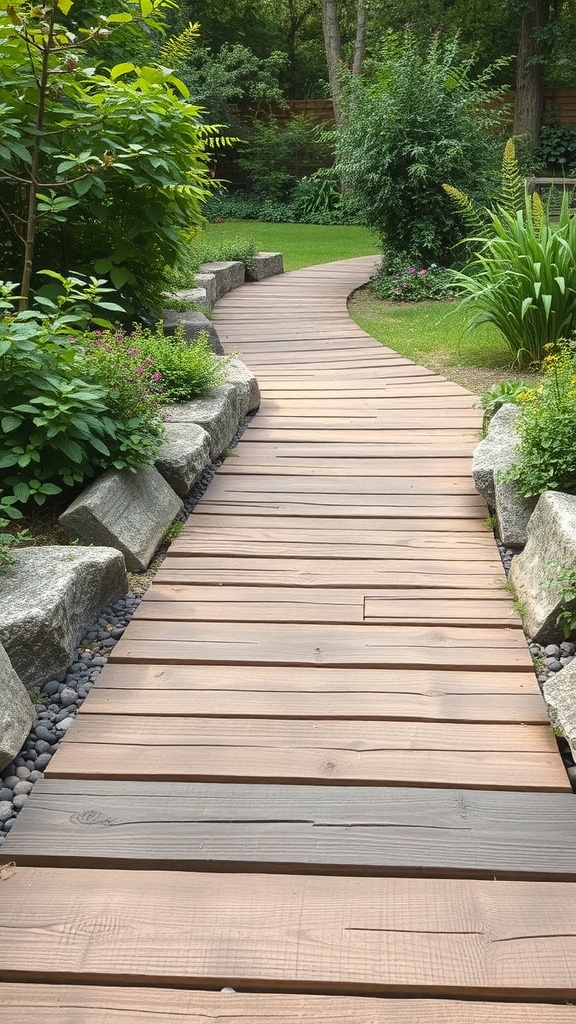
Using natural materials in garden paths creates a warm and inviting atmosphere. The image shows a lovely wooden pathway winding through lush greenery. The wooden planks blend beautifully with the surrounding plants, making the path feel like a part of nature.
Stone borders line the path, adding texture and stability. These stones not only enhance the look but also help define the space. The combination of wood and stone is a great way to create a rustic feel.
Incorporating natural elements like these can make your garden path not just functional but also a visual delight. It encourages a connection with nature, making every stroll feel refreshing.
Lighting Up the Path

Creating a beautiful garden path is not just about the plants and stones; lighting plays a key role too. The image shows a charming walkway illuminated by warm lanterns that guide the way. This lighting adds a cozy feel, making the path inviting even at dusk.
As the sun sets, the soft glow from the lanterns highlights the textures of the path and the surrounding greenery. The way the light dances off the plants creates a magical atmosphere. It’s perfect for evening strolls or gatherings with friends.
Choosing the right lighting can transform your garden path into a stunning feature. Whether you prefer classic lanterns or modern fixtures, the goal is to enhance the beauty of your outdoor space. Consider how the light interacts with the plants and the path itself to create a harmonious look.
Creating Curved Pathways
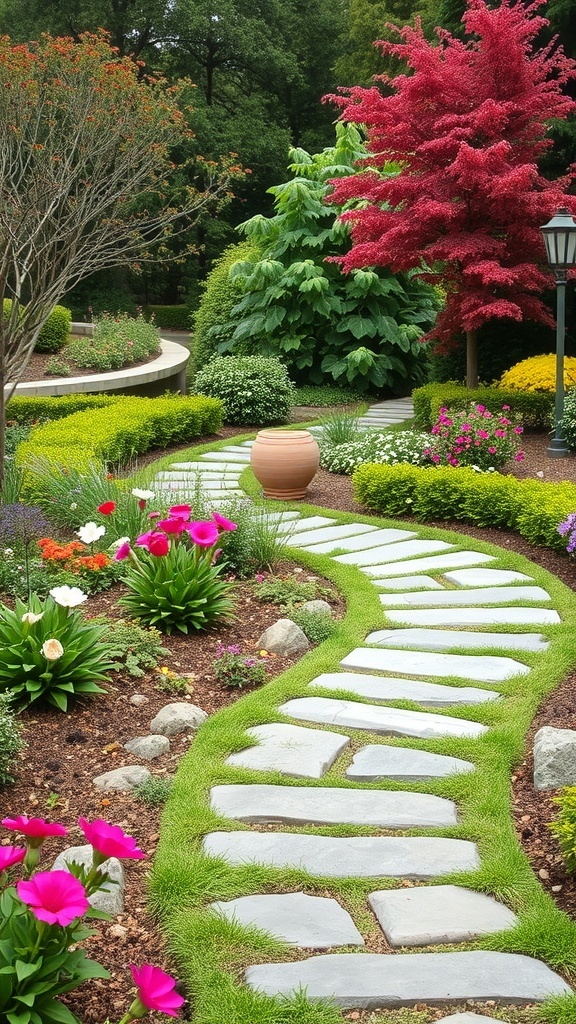
Curved pathways can add a delightful flow to any garden. They invite visitors to explore and create a sense of movement. The image showcases a beautiful example of this design. The winding stones lead the eye through a vibrant landscape filled with colorful flowers and lush greenery.
The gentle curves of the pathway soften the overall look of the garden. They break away from traditional straight lines, making the space feel more inviting. Notice how the stones are set in a way that allows grass to peek through, adding a natural touch.
Alongside the path, various plants bloom, providing pops of color. The red tree stands out, drawing attention and creating a focal point. This combination of elements makes the garden feel alive and welcoming.
When designing your own curved pathway, think about the materials you want to use. Stone, gravel, or even mulch can work well. Consider how the path will interact with the surrounding plants. A well-placed curve can enhance the beauty of your garden.
Seasonal Plantings Along the Path

Walking down a garden path lined with colorful flowers is a delightful experience. The image shows a charming stone path that meanders through vibrant blooms. Each season brings its own palette, and this path is no exception.
In spring, you might see cheerful daisies and tulips bursting into life. As summer rolls in, sunflowers and zinnias take center stage, adding warmth and brightness. Fall introduces rich hues with marigolds and asters, while winter can bring evergreens and winter blooms for a touch of color.
Planting seasonal flowers along the path not only enhances the beauty but also creates a dynamic landscape. The changing colors and textures keep the garden lively and engaging throughout the year. It’s a simple way to bring joy and a sense of connection to nature.
Consider adding a mix of perennials and annuals for continuous blooms. This approach ensures that there’s always something to admire as you stroll along. The path becomes a living canvas, showcasing the beauty of each season.
Pathways with Edging
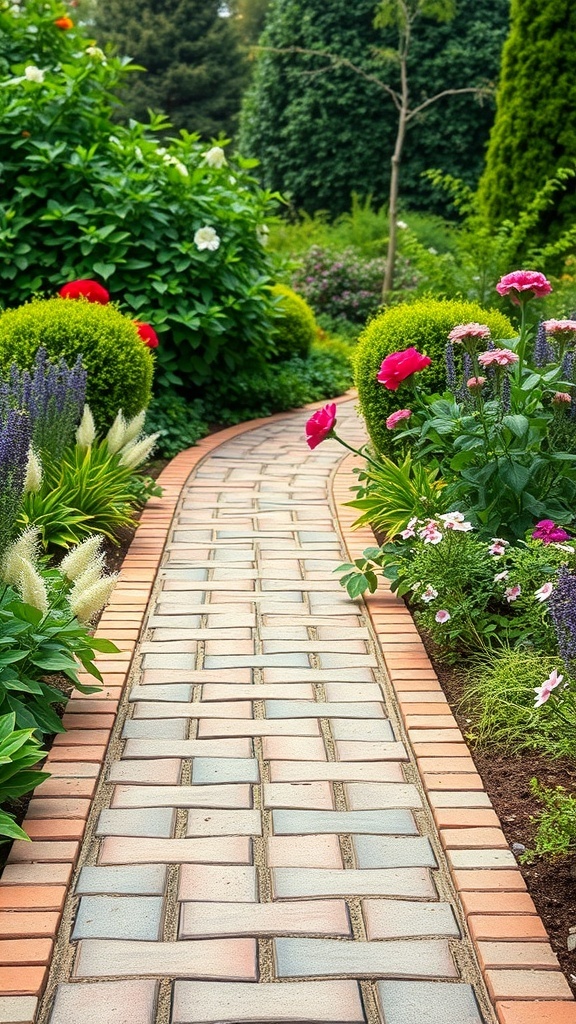
Creating beautiful pathways in your garden can really enhance its charm. The image shows a lovely pathway made of bricks, bordered by vibrant flowers and lush greenery. This design not only guides visitors through the garden but also adds a touch of elegance.
The pathway is lined with colorful plants, which bring life to the space. The combination of different flower types and shapes creates visual interest. The neat edges of the pathway help define the space, making it feel organized and inviting.
Using edging materials like bricks or stones can help keep the pathway intact and prevent grass or soil from spilling onto it. This practical approach also adds a finished look to your garden design. Consider matching the colors of the edging with the plants around to create a cohesive look.
Overall, a well-designed pathway can be a focal point in your garden. It encourages exploration and enjoyment of the natural beauty surrounding it.
Using Colorful Pavers
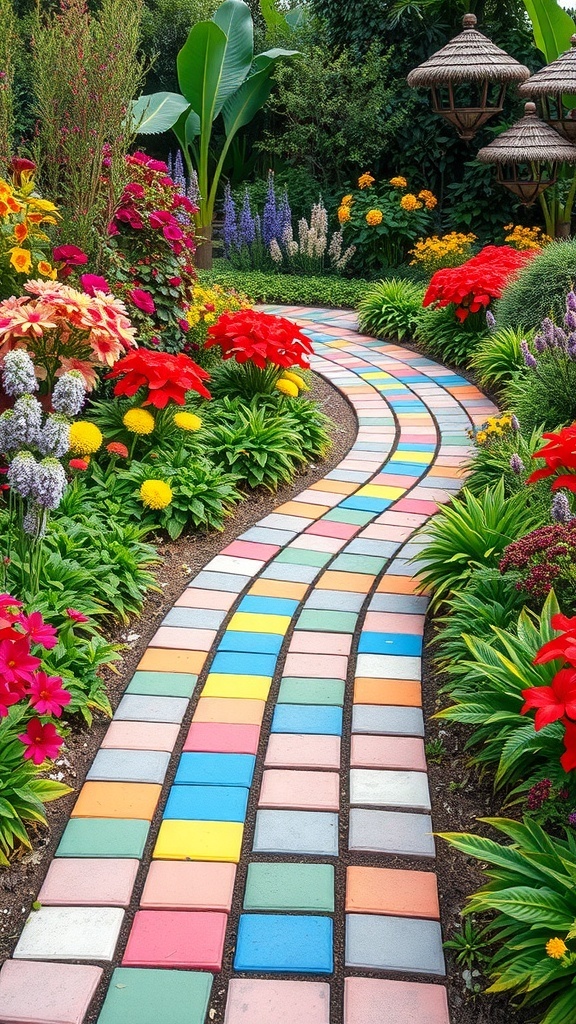
Colorful pavers can completely change the vibe of your garden path. The image shows a winding path made of vibrant tiles that catch the eye. Each paver adds a splash of color, creating a playful and inviting atmosphere.
These pavers are not just functional; they also enhance the beauty of the surrounding flowers. Bright reds, yellows, and blues complement the lush greenery and blooming plants. This combination makes the garden feel alive and cheerful.
When choosing pavers, think about how they fit with your garden’s theme. You can mix and match colors to create patterns or stick to a single hue for a more uniform look. Either way, colorful pavers can guide visitors through your garden while adding a touch of fun.
Integrating Water Features
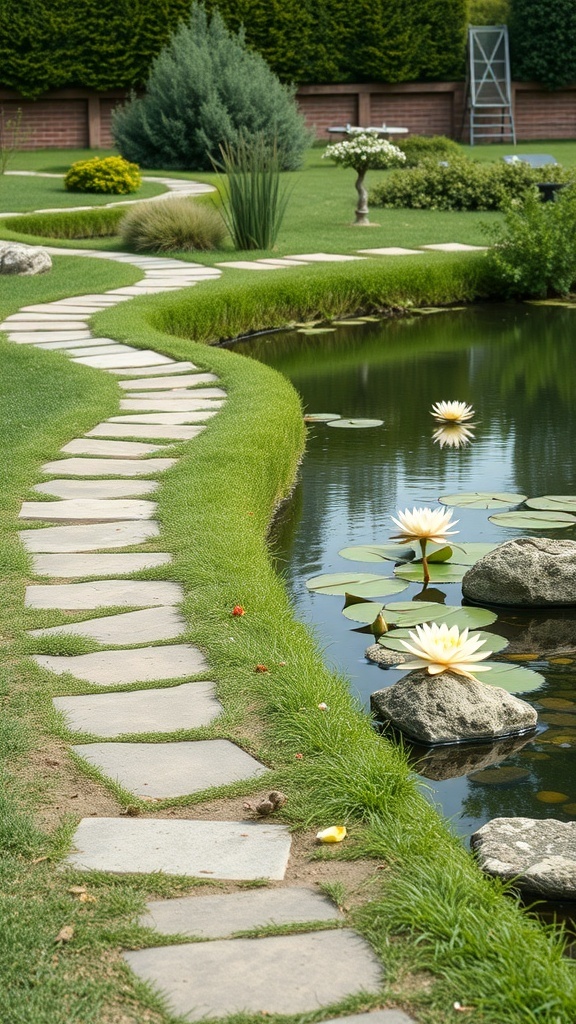
Water features can truly transform a garden path into a serene escape. The image shows a lovely stone pathway that winds gracefully alongside a tranquil pond. This setup invites you to take a leisurely stroll while enjoying the beauty of nature.
The pond is adorned with elegant water lilies, which add a splash of color and charm. These flowers not only enhance the visual appeal but also attract wildlife, creating a lively atmosphere. The gentle sound of water can be soothing, making it a perfect spot for relaxation.
Incorporating a water feature like this can also improve the overall design of your garden. It breaks up the greenery and adds a focal point that draws the eye. Whether you choose a pond, fountain, or a small stream, the key is to ensure it complements the surrounding landscape.
Consider the placement of your water feature carefully. It should be easily accessible and visible from different angles. This way, you can enjoy the view from various spots in your garden. A well-placed water feature can create a sense of harmony and balance, enhancing your outdoor space.
Creating a Zen Garden Path
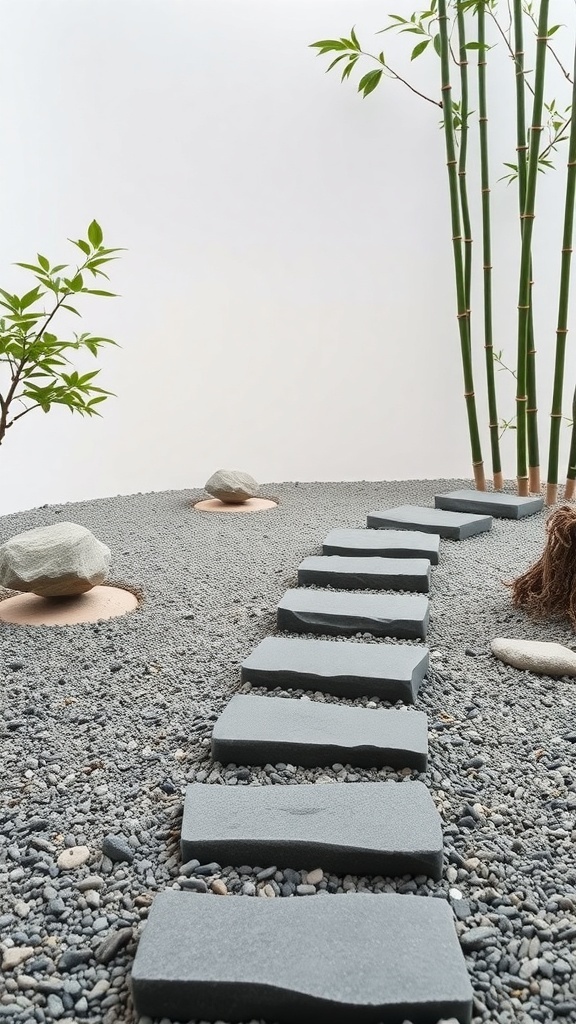
A Zen garden path can transform your outdoor space into a peaceful retreat. The image shows a simple yet elegant path made of flat stones, leading through a gravel area. This design encourages mindfulness and relaxation. The stones are placed thoughtfully, guiding the eye and foot along the way. On either side, you can see bamboo and small plants that add a touch of greenery without overwhelming the space. The gravel creates a calming texture, inviting you to walk slowly and enjoy the moment. This setup is perfect for meditation or quiet reflection. You can also incorporate small rocks and minimalist features to enhance the Zen vibe. A garden path like this is not just functional; it’s a beautiful part of your landscape that promotes tranquility.
Pathway Maintenance Tips
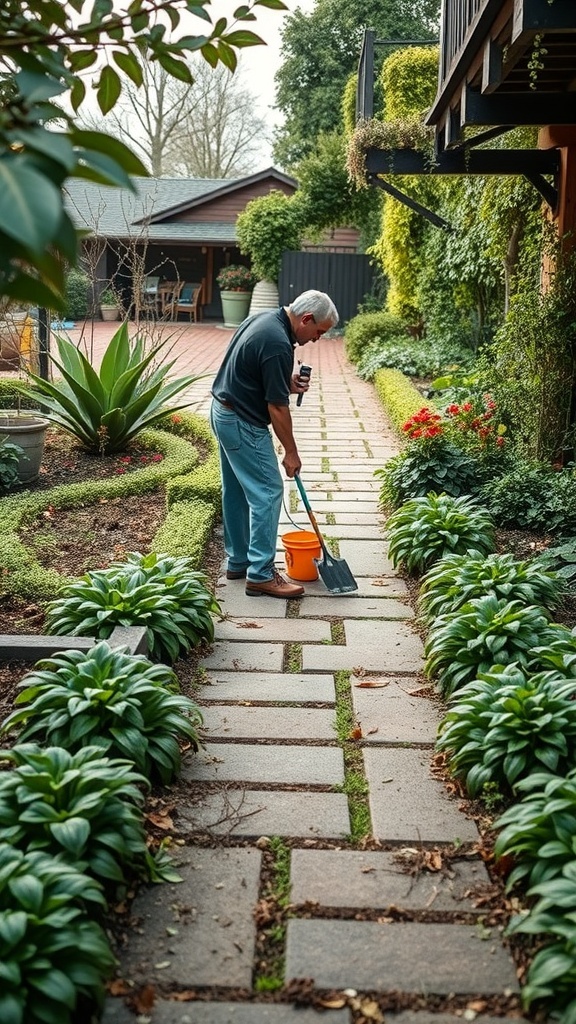
Maintaining your garden paths is key to keeping your outdoor space looking great. In the image, we see a person actively caring for a stone pathway surrounded by lush greenery. This scene highlights the importance of regular upkeep.
Start by clearing debris like leaves and dirt. A simple broom or a small shovel works wonders. Keeping the path clean not only looks nice but also prevents slippery spots.
Next, check for any loose stones or uneven sections. Fixing these can help avoid tripping hazards. If you notice gaps between stones, consider filling them with sand or gravel to keep everything in place.
Weeds can be pesky, but a little effort goes a long way. Pull them out by hand or use a weeding tool to keep your path tidy. Regular weeding will save you time in the long run.
Finally, think about seasonal maintenance. In fall, clear leaves to prevent mold. In spring, a good wash can refresh the stones. Keeping a schedule makes it easier to manage your pathway.
Incorporating Raised Beds
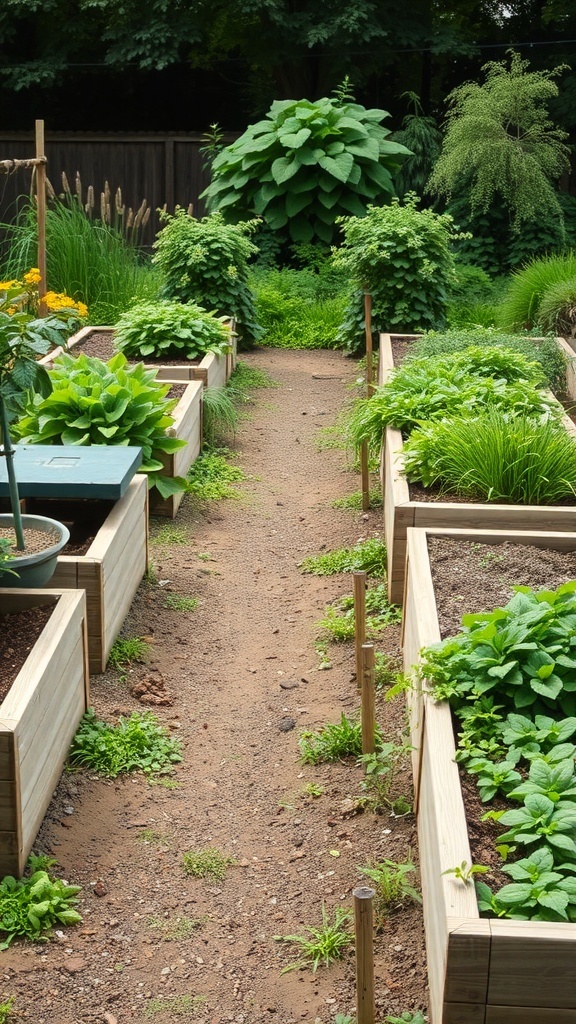
Raised beds are a fantastic way to enhance your garden. They provide a structured space for plants, making it easier to manage your garden. The image shows a lovely setup with wooden raised beds filled with lush greenery.
These beds create defined areas for planting, which helps in organizing your garden. You can see how the paths between the beds allow for easy access, making it simple to tend to your plants. This design not only looks great but also promotes healthy growth.
Raised beds can improve drainage and soil quality. They warm up faster in the spring, giving your plants a head start. The image captures a variety of plants thriving, showcasing the benefits of this gardening method.
Adding raised beds can also reduce the strain on your back. You won’t have to bend down as much, making gardening a more enjoyable experience. The neat lines of the beds create a visually appealing layout that draws the eye.
Consider incorporating different heights for your raised beds. This adds dimension to your garden and can help with plant selection. Whether you’re growing vegetables, herbs, or flowers, raised beds can be tailored to fit your gardening goals.
